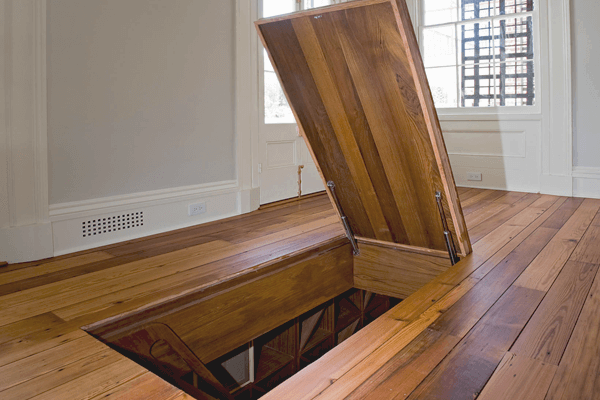Trapdoors are hinged or gliding doors attached to a floor or ceiling so that when it is opened, it allows access to an area below. Traditionally, it could be small or big enough to fit a human. A trapdoor swings open and down. It is often installed as foyers to a basement, attic, or home areas that are impossible to walk through normally and are not commonly used nowadays.
It can also be used as an entrance or exit from a room or any enclosed space.
A trapdoor provides one with a convenient method of moving between floors and acts as a way toaccess a crawl space underneath your floor. Trapdoors may be marked or made to blend in with surroundings to prevent unauthorized people from accessing them.
Trapdoors were used during medieval times to hide people during war periods.
Building a trapdoor is quite easy, like creating a wooden door frame. All you need to do is make your layouts, cut out your opening, create the door frame and finally build the door.

Related Articles
Basement Floor Drain Backs up When Toilet is Flushed
Sewage Backup In Basement Health Risks
Water Coming Up From Basement Drain After Rain
Contents
Functions of Trapdoor
As earlier mentioned, trapdoors were used during the medieval era to protect people from wars and other dangerous elements such as a fire outbreak or a storm. (This could be a case, especially for trap doors designed inside a ship.)
In some homes, a trapdoor leads to a small storage space, where valuable items are kept to protect them from thieves. This type of trapdoor is often referred to as a smuggler’s hole.
In the military, trapdoors are used for underground movement between the different phases of a base or fort. They are also used for accessing technical areas that are underground.
For media purposes, actors or performers often use trapdoors to vanish from the stage. For example, a magician uses a trapdoorto create a fantasy or illusion in his show.
Trapdoors not only lead down to an underground basement but can also be used to enter high spaces, like an attic, for example. Often, these trapdoors are used with a retractable ladder.
How to Build a Trapdoor on the Floor
A trapdoor is a type of door used in buildings and other major facilities. It is made up of two hinged boards that are connected to a door frame so that when it is opened, it allows easy entry to an area below.
Below are some steps or tips to follow when making a trapdoor.
- Remember to wear an eye or ear protector if you’ll be working with power tools.
- Plan out your proposed trapdoor area.
- Use a pry bar to remove tiles or floorboard, to allow easy access to the subfloor.
- When marking the trapdoor location, use chalk and a ruler to mark out the lines. There is no particular size to a trapdoor; however, the size can be determined by how big you want it to be.
- Add two inches to whatever measurements you make to allow for an overhang of the door.
- Following the chalk line, you’ve drawn, cut along with a circular saw. When done, pull out the cut part with your pry bar.
- Measure the distance between the inside faces of the joist and create a supporting frame on all four sides.
- Cut out the wood that is an inch smaller than the width and length of the floor hole. Then test the wood in the spot to see if it fits.
- Measure a space for the double plank you set in between joists.
- Place hinges onto each side of the frame and on the edge of the wooden door.
- Screw hinges tightly.
- Drill a hole for your handle, and then use construction cement to glue it in place.
- Leave the door overnight to ensure it is glued well before use.
FAQs
How do trapdoors operate?
A trapdoor works as a normal door would; this includes pushing or pulling open. A trapdoor enables one entry to either step down or goes up. They are often made with wooden materials and a hinged lid that swings out or opens downward to reveal an entrance beneath. Sometimes, when there is no handle or grip available, a trench is cut into the ground to allow a grip on the side of the door. They can even depend on gravity to remain close- though this depends on whether it is opened upwards or downwards.
Are trapdoors helpful?
Trapdoors are effective, and they have both good and bad benefits. Although it can be used to access a safe place underneath a building, it has its limitations.
One has to be cautious when making use of a trapdoor. They need to confirm that the door’s hinges are not busted and can be opened well. This is to avert being locked inside as there is little air when one is trapped inside.
What does a trapdoor design look like?
Trapdoors are often rectangular or square-like in shape with hinges and wooden frames. Depending on the period, some trapdoors could be made of metal. The trapdoor design is kept simple for easy passage and to prevent people from entering.
Where are trapdoors generally found?
Trapdoors are commonly found in buildings or facilities that need entry to a basement or attic. It could be inside a residential dwellings or major institutions like a library, a school, or a museum. They can also be found in a military base or fort.
What material is used to make a trapdoor productive?
Trap-doors can be made out of metal, wood, or other material, depending on the time period and equipment available. They can even be made out of plastic for a certain reason, especially for an inboard yacht. Despite this, they all have a thing in common, and that is the hinge placed on each side that allows for easy swinging of the door.
CONCLUSION
Trapdoors are often built to be hidden from view or to blend into the floor or roofs. And because they are not commonly used nowadays, trapdoors often hold a unique sense of mystery which plays a part in how they are designed.
